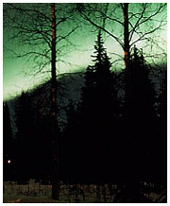 The aurora often is seen as a steady auroral arc.
The aurora often is seen as a steady auroral arc.
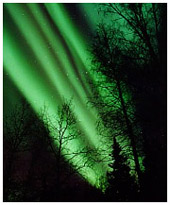 Sometimes, single arcs will split into multiple auroral arcs.
Sometimes, single arcs will split into multiple auroral arcs. And sometimes the aurora will erupt into many auroral arc filaments that move rapidly across the sky
And sometimes the aurora will erupt into many auroral arc filaments that move rapidly across the skyIf you are standing in Alaska, Canada, or the Northern United States on a clear dark night and looking up into the sky, you may see a bright greenish-white band of light that stretches across the sky from the East to the West. You are seeing the Northern Lights, also known as the Aurora Borealis. These types of lights also occur near the South Pole, where they are known as the Southern Lights and Aurora Australis.
On a lucky night, you may watch this auroral band continue to brighten as it moves toward the South. Then, within minutes, you may see the band of light break into many bands of light some of which will move back overhead and to the North, dancing rapidly and turning red, purple, and white. If you've been lucky to see this sequence of events, you have witnessed the beginning phases of an auroral substorm.
When we see these dancing auroral lights evolve suddenly from a slowly moving auroral arc across the sky, we know that there are two distinct processes occurring in Earth's magnetosphere. But which one triggered the abrupt change from a calm aurora to a dancing aurora?
Themis, the goddess of justice, wisdom and good counsel, the guardian of oaths in Greek mythology, represents the THEMIS mission. She will confirm without prejudice, as implied by her fame, one of the two competing theories for auroral eruptions. THEMIS, with her sword (representing instruments) and scales (representing science discoveries), has both power and impartiality.
All-Sky cameras are special "movie" cameras used to study the aurora. These cameras look up into the sky and take black and white movies of the aurora from horizon to horizon. A THEMIS All-Sky camera has captured this beginning sequence of an auroral substorm. You can find out more about All-Sky cameras in the Gallery and Activities Page, where we show many different movies of All-Sky cameras located in Canada and Alaska.
Below is a sequence of images that follow the beginning substorm phases: the brightening of an auroral band and then the sudden splitting of the arc into many forms of light dancing overhead, expanding towards both the North and the South. All images have been provided by the University of Calgary.
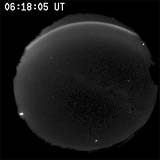 |
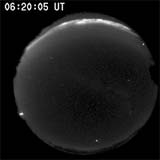 |
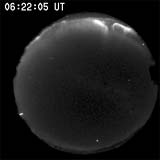 |
| A slowly moving auroral arc is seen to the North (top of image). | The auroral arc brightens suddenly and begins to move more rapidly. | The arc begins to split into many arcs which move toward the South (toward the bottom of the image). |
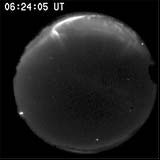 |
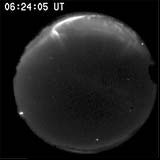 |
 |
| The arcs now move rapidly, continuing to move toward the South | The arcs change into even smaller features and into auroral patches that pulsate on and off every 3 seconds or so. The aurora continues to move toward the South | Most of the aurora has become patches that pulsate and no more auroral arcs can be seen. |



